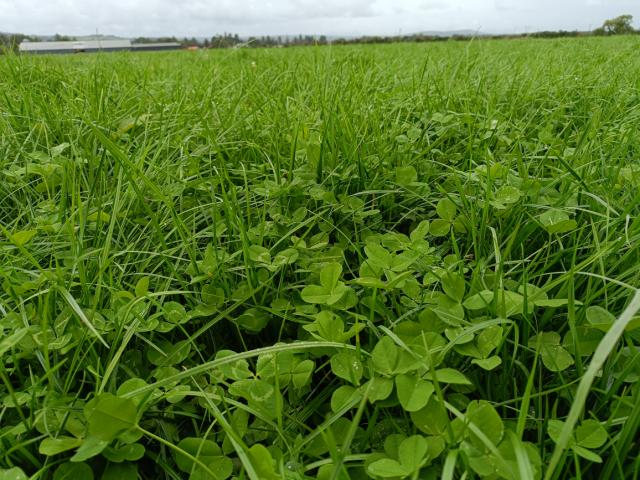
White Clover
White clover is the most commonly sown legume in Ireland and is primarily used for grazing in mixtures with grass.
As a forage, white clover is highly digestible with crude protein content averaging over 20%. But the most significant benefit of white clover is its ability to fix N from the atmosphere for use by neighbouring grasses in the sward.
The use of white clover in grass mixtures has the potential to offset up to 150kg N/ha per year in inorganic N fertiliser. With fertiliser prices increasingly volatile, the incorporation of white clover into grass swards has the potential to greatly reduce the reliance on inorganic N fertiliser and increase the financial and environmental sustainability of Irish farms.
For maximum benefit a sward white clover content of 20-30% is required
Benefits of White Clover in the Sward @ 20-30%
- +800kg DM/ha
- Opportunity to reduce N fertiliser
- Dry matter intake +1.5kg/cow per day
- Milk solids +30kg MS/cow per year
Establishing and Managing White Clover in the Sward
Establishing white clover takes time and some specific management. DLF recommends targeting up to 30% of the farm at a time in which to establish white clover. Achieving good white clover content across the farm should be a medium-term goal and should be carried out over a number of years.
A full reseed is the most reliable method of establishing white clover. However, as the options for post-emergence treatment become more limited, many farmers are choosing to over-sow white clover into existing swards.
No matter what sowing method used the 4 key principles of successful establishment and management of white clover should always be considered.
Soil
- Ensure adequate soil P, K and pH status
- Sow seed no more than 1cm deep
- Roll to ensure soil-seed contact
Timing
Sow when soil is warm (+10°C), and there is some moisture – ideally April to Ma
Seed
- Over-sow at a rate of 2 – 2.5kg/acre
- Use small and medium-leaf varieties for grazing and large-leaf for cutting
Light
- Over-sow after a tight grazing or silage cut so light can stimulate seedling growth
- After sowing, graze at ~1,100kg DM/ha for the following 3 rotations to establish adequate white clover content
8 Steps to Successfully Over-sow White Clover
- Select a paddock with good soil fertility and an open sward to allow soil-seed contact.
- Broadcast or direct-drill seed at a rate of 2 – 2.5kg/acre after tight grazing or a silage cut
- If broadcasting, sow ‘twice’ – half rate down, half rate across the paddock
- Sow seed no more than 1cm deep if drilling
- Over-sowing should take place between April and June, ideally.
- Roll after sowing to ensure seed soil contact. This will improve germination rates.
- Allow light down to establishing seedlings and reduce grass competition by grazing ~10 days after sowing. Watery slurry may be applied at this stage.
- Continue to graze at low covers (~1,000kg DM/ha) for the following 3 rotations using half rates of N after each grazing.
- Once white clover is established, continue to graze maximum 1,600kg DM/ha covers down to 4cm applying N tactically.
- Where white clover content is >20% N fertiliser can be significantly reduced from May onwards.
.jpg&width=640&format=webp&quality=99)

Grazing Management
White clover should be managed with the aim of maintaining a sward clover content of 20-30%. This can be achieved by a combination of reducing inorganic N application and good grazing management. When grazing grass-white clover swards it is important to graze covers of no more than 1,500kg DM/ha down to ~4cm residuals. This prevents the grass outcompeting the white clover and allows sufficient light down to the clover stolons at ground level. An early spring grazing will allow light into the sward to stimulate growth while leaving high clover swards for grazing last in the final autumn rotation will reduce the risk of winter grass growth smothering the white clover.
It is important to reduce inorganic N application on grass-white clover swards during the summer when white clover is most active and fixing N from the atmosphere. Where white clover content is above 20% in the sward, it is advised to reduce N application by half from May to encourage clover growth and maximise the amount of free N fixed by the plants.
Learn More About White Clover
Want to know more? Reach out to your local DLF representative today or leave us a message using our chat widget!